March 11, 2020
Step One: Don't be an Ass. Step Two: Make Quilts
Hi there!
Recently, I’ve been thinking a lot about inspiration, derivation, copyright protection and more in the context of modern quilting. Why? Because I’ve had a few personal experiences where the delicate nature of inspiration and derivation has affected me. And because I’ve been a spectator to a number of scenarios in the quilting industry where these touchy subjects have come up.
I am just one voice in the modern quilting world, and I don’t expect to have that much of an influence on anyone in particular, but I did want to organize and present my thoughts given these recent experiences, and then get back to quilting.
A wise quilty person suggested to me that I be upfront about my intent in writing this blog post. Here are my goals, in my favorite form (a list!):
- Influence the discussion of inspiration and derivatives in a positive direction
- Share and acknowledge the hurdles we have in creating original work in quilting
- Encourage kindness and not ass-ness when discussing inspiration and derivation
So, here goes...
Chapter 1: Inspiration
First off, I’ll start with inspiration. In an IG story, I asked people what inspires them in their modern quilt design. Here are some of the answers that I received:
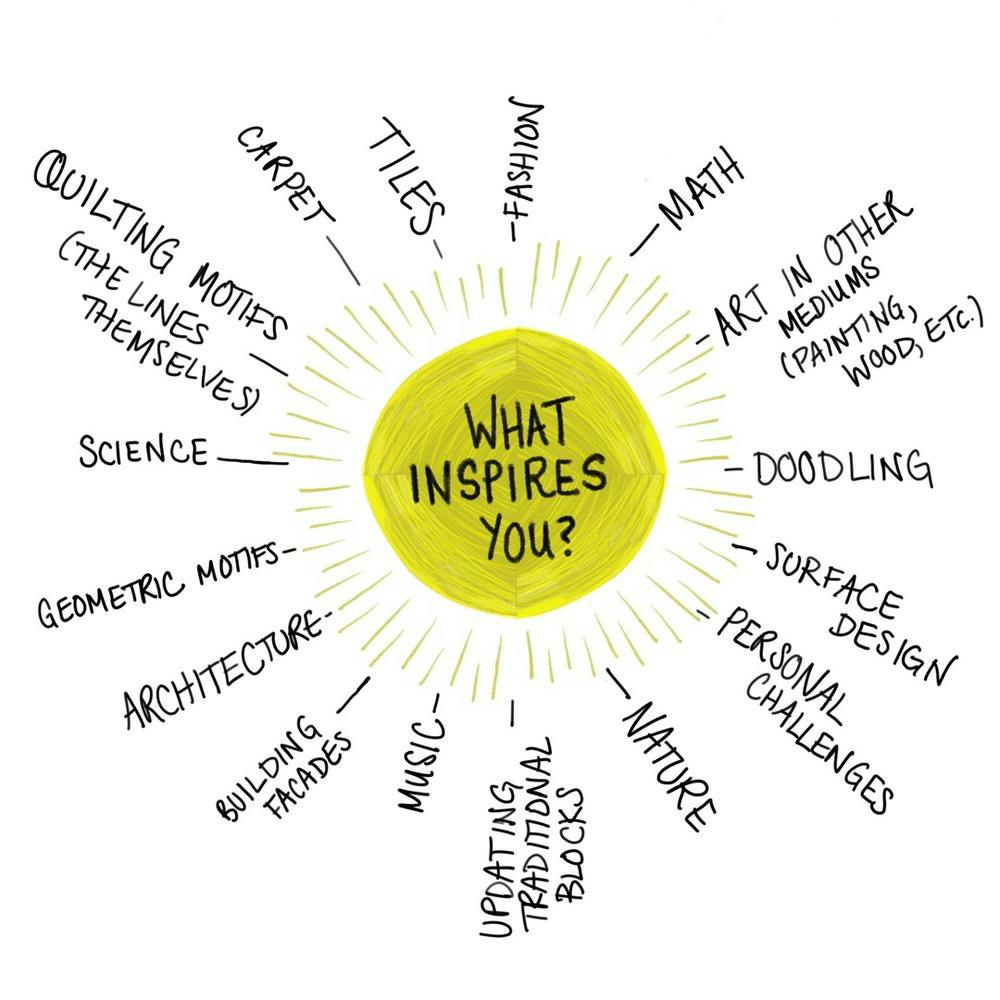
There was a follow-up conversation on my IG post here. My main takeaway of that follow-up IG conversation was that we can be indirectly inspired by other quilters in terms of work ethic, their process, or even how they have been successful in marketing and selling in the industry, but that doesn’t mean that inspiration is directly related to design or aesthetics.
Many things inspire people in different ways. In my opinion, one common thread is that makers who are interested in creating original design are observant in the world around them, and curious to see how elements in the world around them can be applied to quilting directly or indirectly.
Chapter 2: Execution
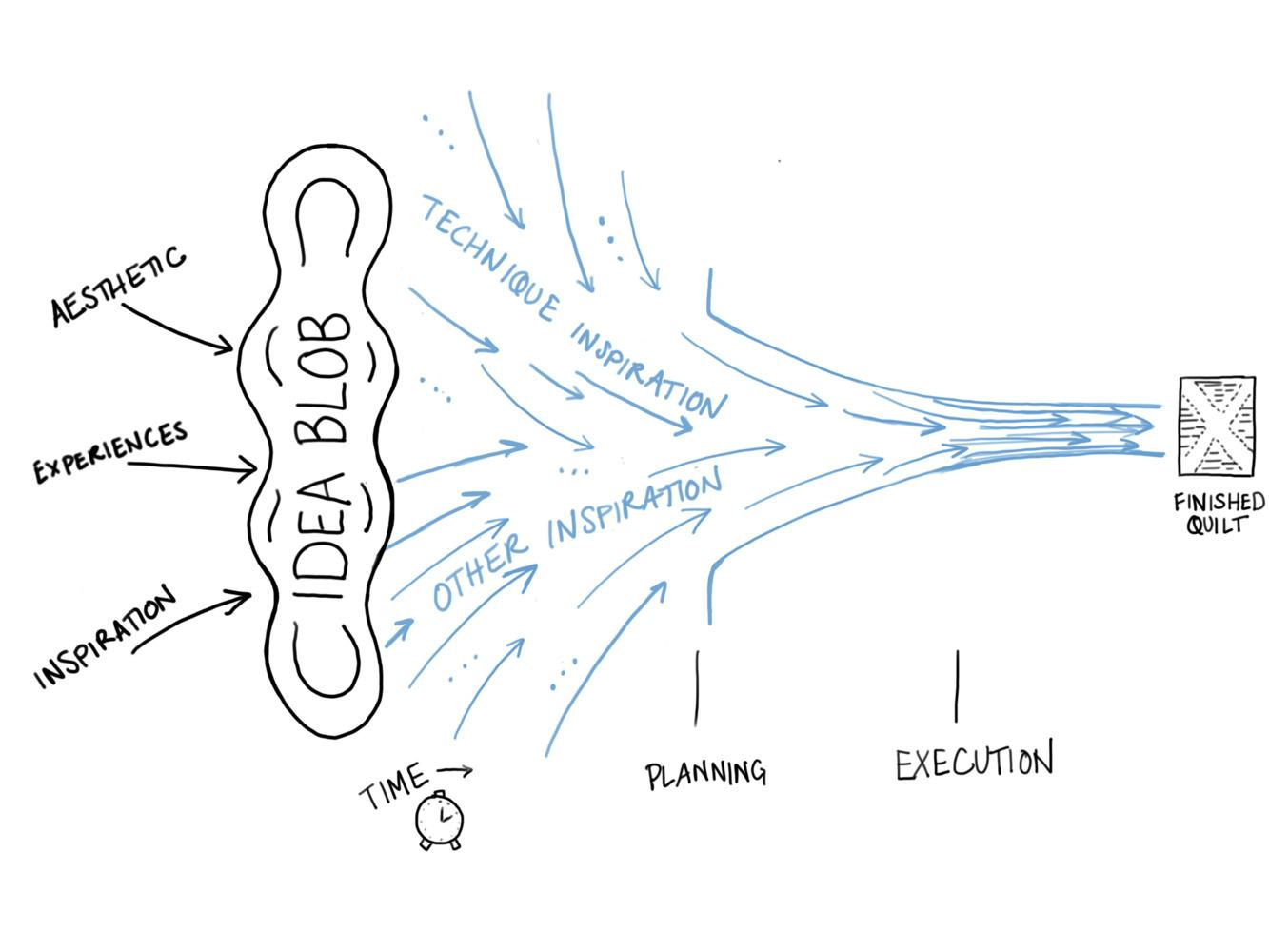
I’m very interested in how one funnels inspiration to make a decision to execute a quilt. I can only speak to my personal process here.
For me, I start with an idea blob (i.e. a seed of an idea). The idea blob comes from a mixture of my past experiences, aesthetic, and inspirations. Some examples:
- I really like the idea of drawing negative space shapes with many lines
- I like the Rail Fence pattern, but how would it work with more negative space
- I want to experiment with complementary colors with high/low values
Usually, I let an idea blob sit for a while. Sometimes, it leads to sketches and visualizations. Sometimes, I see things in the world around me (e.g. on social media or out and about) that relate to this idea, and it’s pushed forward with minor adjustments.
If the idea blob eventually solidifies, I begin to think about execution of the idea, which might include investigating how other quilters use specific techniques in their designs that I think I can leverage. Or it might include experimentation if no technique is a clear starting point.
Usually I have many more ideas than time to execute those ideas, and I decide what’s next based on excitement and my ability to execute that idea. For others, commercial interests might influence this decision. Whatever the case, something pushes that idea blob to a plan and I start cutting and sewing fabric.
I can only imagine that other people’s processes to funnel inspiration to execution is similar to mine, but I'm sure it varies from person to person and quilt to quilt. Like I said, I can only speak to my process and I encourage others to find what works best for them.
Chapter 3: Copyrights
Strong caveat: I’m not a lawyer. I strongly advise you consult legal advice if you need something more than a high level review from me.
On Technique
Quilters don’t own techniques and ideas aren’t copyrightable (see copyright FAQ here). However, their instructions are copyrightable and those instructions should not be reproduced without permission. Once a technique is shared with someone else, the technique can be adapted and remixed for future sharing, provided new instructional material is created and expression of terminology/instructions is not copied.
Before recent advancements in technology, techniques would have been shared via word of mouth or printed instructions. But now, the barrier to share digital instructional resources is so low that it happens. And unfortunately, this can undercut the original author, when sharing is done without permission ?. On the positive side, digital distribution means that makers can reach a much wider audience than before ?.
While I say that exact instructional material is copyrightable, I can’t comment on what the legal process is for acting when this protection is infringed upon. It’s likely cost prohibitive to pursue damages, i.e., the damages recovered may not cover the cost of a lawyer.
Fine print: While I say that instructional material and finished pieces are copyrightable, in the US, you have to register your copyright if you wish to bring a lawsuit for infringement. Other countries have different laws and I don't know them all!
More fine print: A quilter can also protect particular terminology, expression, or design as a trademark if they choose to do so, but my understanding of the application of trademarks in quilting (outside of protecting specific branding) is currently limited.
On Specific Artworks
Reproducing specific artworks in different forms without the permission of the original creator is a violation of copyright. For example, I can’t take a photo of someone’s quilt and reproduce it on a postcard, without permission. Or, if I download a photo of someone’s project on their website, I shouldn't put it on a book and sell it. Or, I can’t take someone’s finished quilt design and turn it into really awesome socks to sell. BTW, I love quilty socks.
While these examples of reproduction are copyright violations, pursuing legal action as a result of copyright infringement can also be cost prohibitive here.
On Artistic Voice and "Brand"
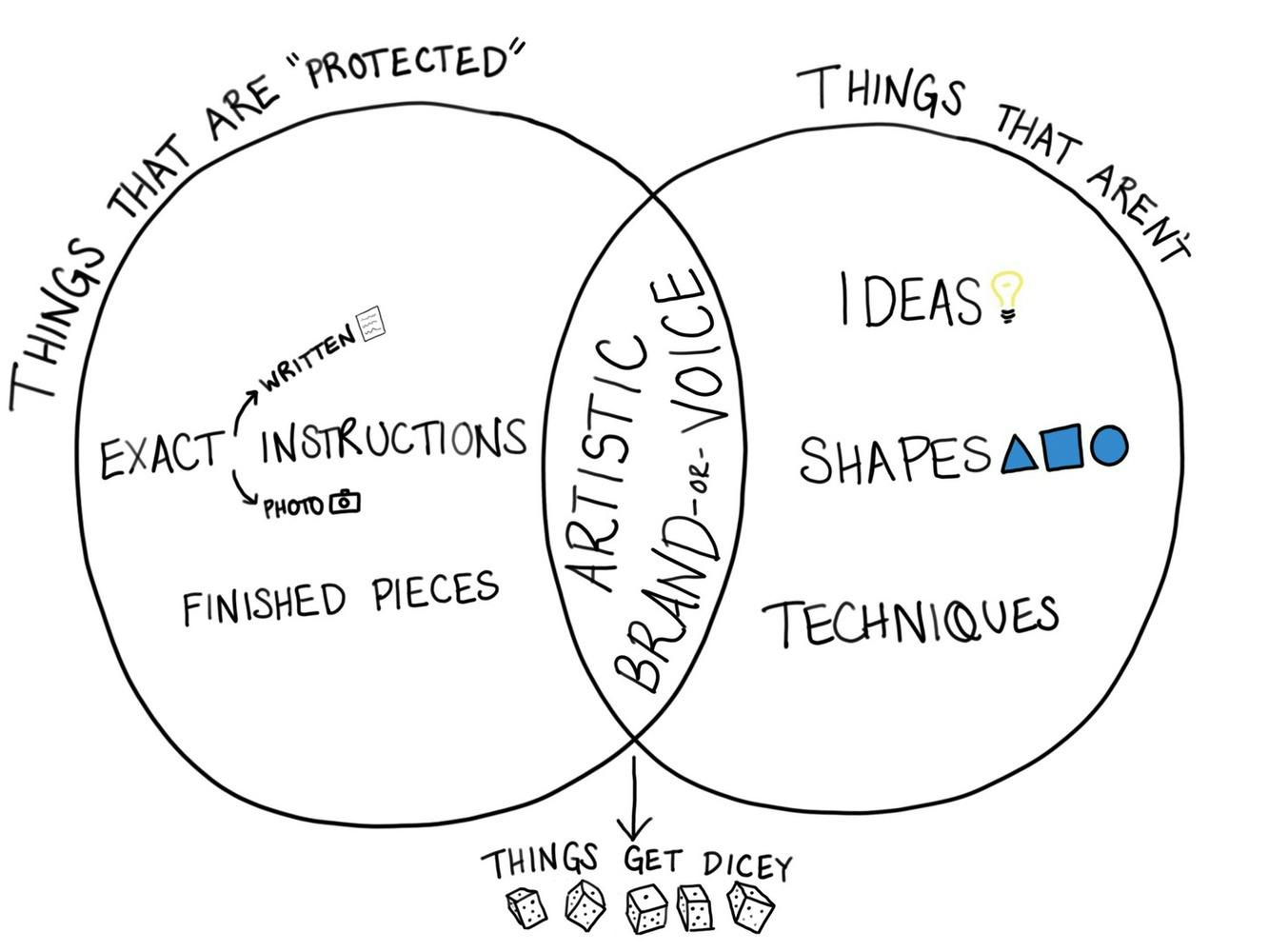
I think things get delicately dicey because quilters want to protect their artistic voice and brand, which may be built on a foundation of techniques that they have shared, and/or their use of simple shapes, and/or specific artworks.
Back to what I was saying above, techniques, ideas and simple shapes are not copyrightable, but specific artworks are. If an artist has built their brand on a set of techniques, unfortunately, there is no legal protection for those "ideas" outside of their instructional material. But if the artist has built their brand on their own created artworks and shared those in various forms, those artworks are individually copyrightable.
In my opinion, protecting artistic voice is especially dicey in the quilting space because the industry is built on sharing patterns and techniques, and therefore inviting reproduction of pieces that can be similar to a representation of the author’s artistic voice.
Chapter 4: Derivatives
By Wikipedia’s definition, a derivative piece is a transformation, modification, or adaptation of an original work. Different countries offer different legal protections for original and “derivative” pieces, as well as different definitions of the word itself.
For me, some examples of a derivative work include:
- you noted the successful elements of a single piece and intentionally sought out to recreate that success
- you followed a pattern to recreate that original piece in different colors
- you followed a pattern and went off on a couple of your own tangents
Even my own definition is flawed. For example:
- What if you noted the "successful" elements of 20 quilts and combined them together into your own successful piece. Is that derivative? I don’t think so, because you are making a quilt based off of your own perception of many other quilts.
- And what if you create a quilt from a transformed public-domain quilt block? Is that derivative? Maybe, but I get very excited to see exciting updates to public-domain blocks.
- And what if the tangents you went off on from following a quilt pattern were so significant that your work no longer resembles the original - would that be a false-negative derivative? Is attribution required here?
I’m just one person, and these are my examples. From my research, I found that there is much debate over what defines a derivative and it is commonly argued in court because of this gray area. There are even more shades of gray with the introduction of transformative works. Here is an article that gives a high level definition of transformative works and some legal examples.
Who’s to judge what a derivative is?
To be clear, I’m not judging you and what you choose to make. Quilt shows put rules in place for pieces they accept in shows, and it is my understanding that a quilt show holds some liability if a contributor creates a derivative piece without permission or attribution.
I personally don’t care if you want to make an exact replica, fiber for fiber, of a quilt that someone else made if that’s how you learn or if that’s the end product you would like. Some quilt shows will accept that piece, and some will not. And some makers will care that some shows will accept that piece, and some makers will not.
Chapter 5: The MQG
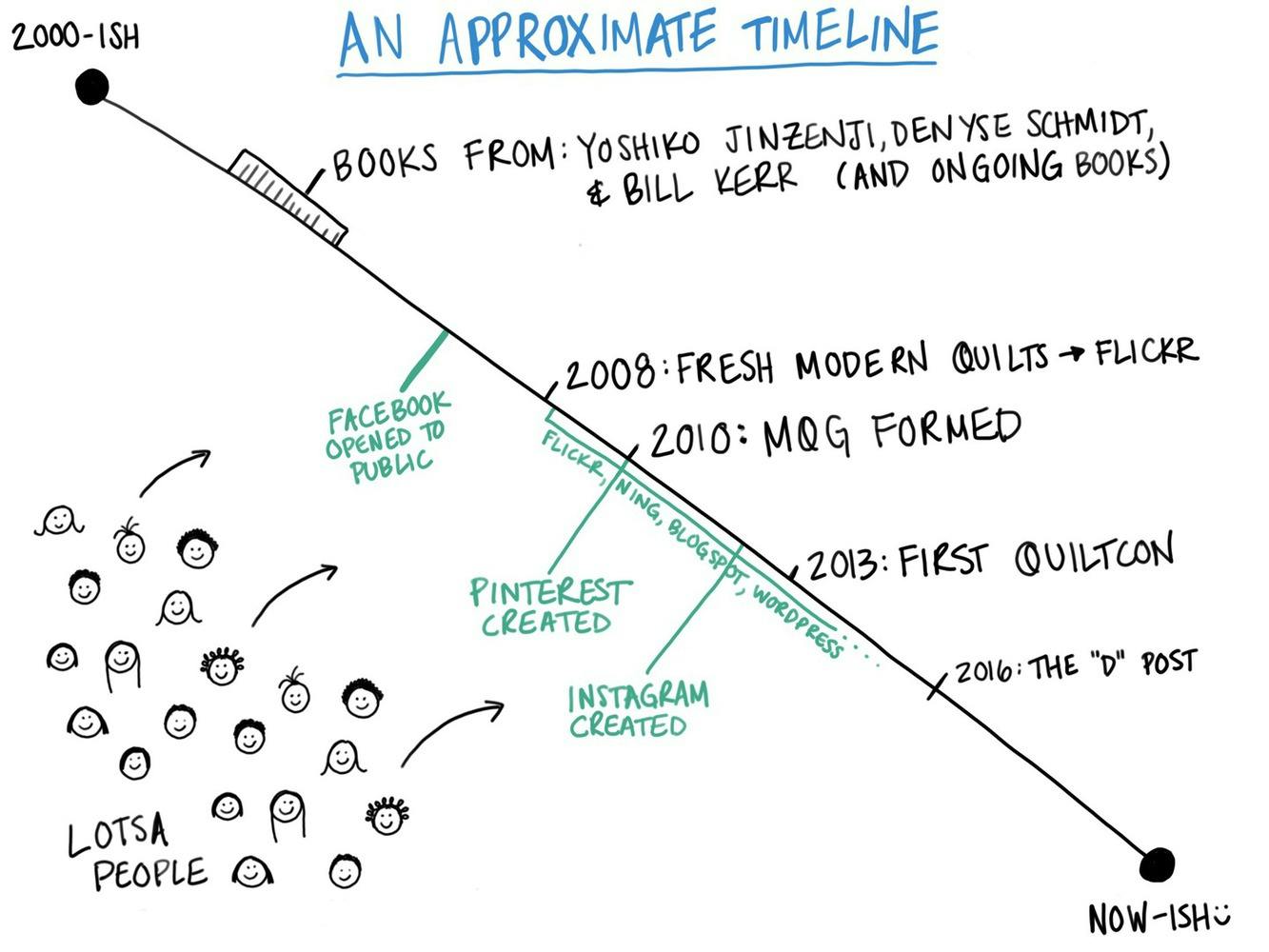
Back when I got really into modern quilting in 2016, I read a lot about the history of The MQG and how it came to be. The MQG is the biggest international guild of modern quilters, and they are responsible for putting on the largest international modern quilt show (QuiltCon). There are smaller modern quilting groups that exist outside of the MQG as well, but the MQG has significantly impacted the centralization, growth and community in modern quilting. By my observation, the success of the MQG and the timing of community driven technology (social media) is not a coincidence.
In 2016, as I was really getting into quilting, the MQG published a blog post on derivative works that was not received well. When I went to QuiltCon this year (2020), I learned a bit of the backstory for the original post. It is now my understanding that the original intent was to:
- Educate members on what a derivative is
- Encourage members to give attribution and/or ask permission when they made derivative pieces
- Encourage innovation
Unfortunately, the points of execution on that 2016 blog article didn’t line up, and the seams were ripped (if I may use this analogy), and the MQG backwalked the post, though they thoughtfully keep the original article and comments available here. Words were said, feelings were hurt, real people were behind internet words, and lessons were learned.
It is not my intent to go digging up skeletons and bad vibes from the past, but I think it's important to think about the lessons learned from this experience (my own experience limited to being a spectator) and understand the delicate nature of creative process, inspiration, and derivatives, while balancing the desire to encourage innovation and creativity with the appreciation of the tradition of quilting. Hindsight is 2020? <-- See what I did there? ?
Chapter 6: On Creativity
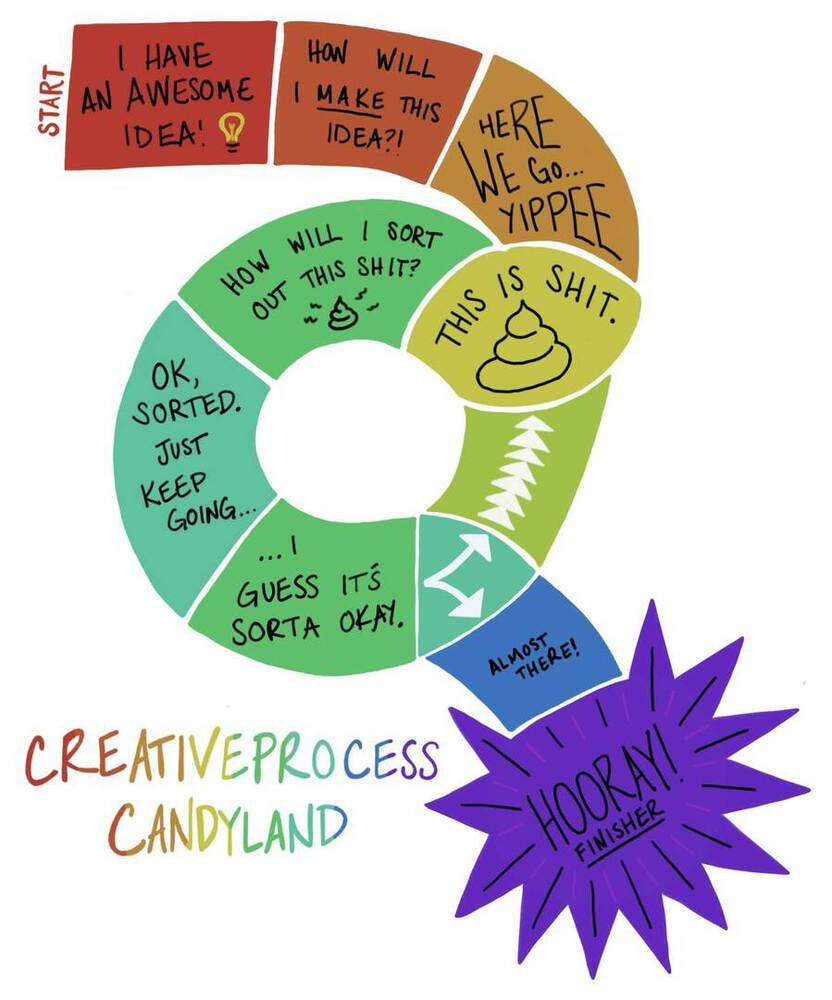
One depiction of the creative process. It can be full of self doubt.
The creative process can be fragile and finicky, but also so empowering when someone makes it across the finish line. There are already things that hinder the creative process (time limitations, all sorts of self-doubt), but add pressure to create original work, and makers can become discouraged, no matter their experience level.
I think a lot about technology and how it affects the modern quilting movement, and how a large portion of the audience coming into modern quilting does not have a formal art education, where "derivatives" and "copying" are common, accepted, and normalized. Layer in the fact that social media has led to an abundance of inspiration at our fingertips. In the past, makers could have evolved to make similar works unknowingly, but technology now makes it so clear when there are similarities between work - Google even has an image match tool baked into photo storage!
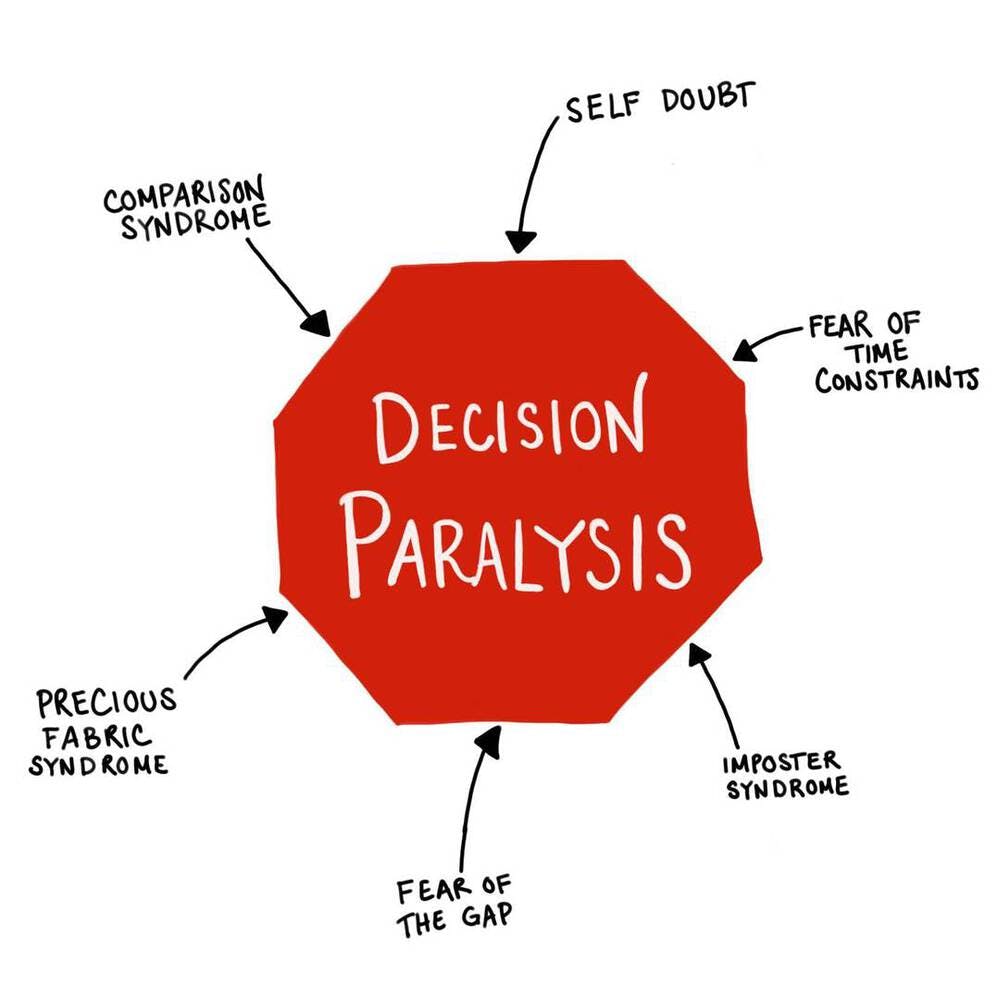
Another way that I look at how external influences can negatively impact our creativity.
While we gain the benefit of community and connectivity with social media, it comes at a cost - the reminder that other quilters are making similar work, the fear that work by another maker influenced us subconsciously, or the fear that someone else will get to our idea first.
Conversations with friends have included the following remarks:
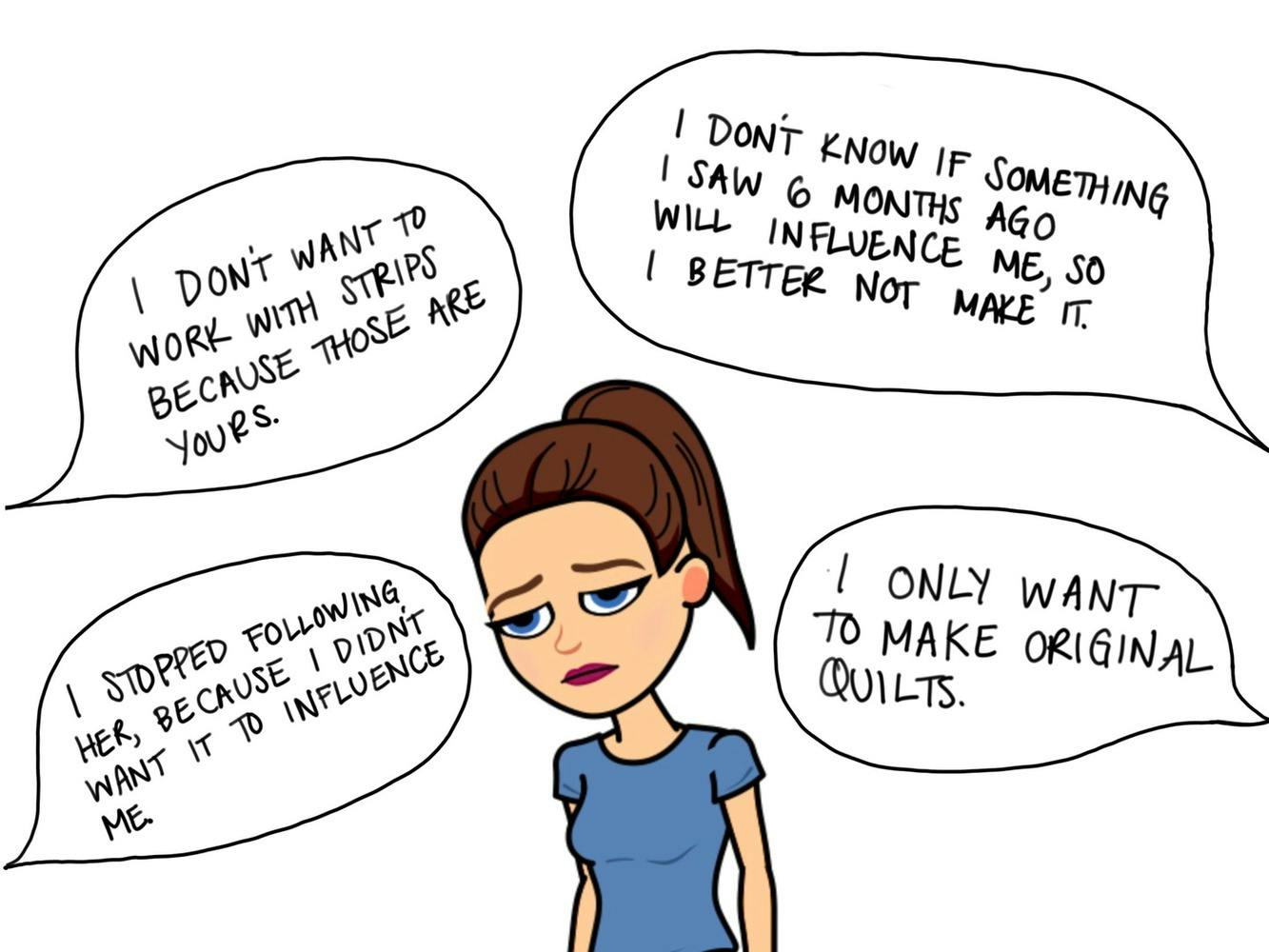
Sad Steph
And, as you can see from my Bitmoji, these remarks make me sad. I want people to be inspired, and to make what they want, whether they are working on a piece to improve their technique, or experiment with creative expression by adopting a tiny dash of style from another maker. Any individual maker’s specific artistic voice is made up of many inspirations, aggregates of style and technique from experimentation, and mixed with their own developing aesthetic and experiences.
But, I think it’s also important to acknowledge that quilting is based on reproducing familiar shapes, so I think it's natural to see similarities between our work when quilting is based on similar shapes. No one owns lines, triangles, circles, arcs, squares, hexagons, pentagons, or wedges. And also, no one owns specific color palettes, quilting motifs, techniques, or ideas. I think it should be pretty normal and expected that we would see familiar representations of shapes and colors modern quilting.
I hope I have painted the picture that I still think it's pretty complicated: We are trying to balance our desire to create original, meaningful work based on our experiences, inspiration, and aesthetic with the challenge of creating quilts based on iterating on relatively simple shapes. All while technology is developing at our fingertips, for better or worse.

The struggle is real.
Chapter 7: Don't Be an Ass, Basically
In conclusion, back to the original intent that I laid out:
Influence the discussion of inspiration and derivatives in a positive direction:
Quilting is based on simple shapes and repetition in the use of shapes and techniques is likely to happen, but each maker puts much effort (in the form of blood, sweat, tears) into their work, blending their personality, perspective, experiences, influences, and techniques learned. There are many amazing, interesting, and moving modern quilting pieces coming from remixed shapes, new shapes, and unique makers that continue to engage me on social media and IRL quilt shows. I have a strong desire and hope to move things in a positive direction when it comes to the discussion around inspiration and derivation.
Share and acknowledge the hurdles we have in creating original work in quilting:
Creating original work is hard, can be lonely, and requires courage. There are many hurdles and moments of indecision. I think the more we can bond in acknowledging these hurdles together, the more we can cheer each other on to get through them, stitch by stitch, quilt by quilt. Sometimes we make mistakes, and learn lessons, and come back stronger the on the next round.
Encourage kindness and not ass-ness when discussing inspiration and derivation:
Mostly my “pitch” is to just keep making and be a kind human. It’s entirely possible that two people can evolve to make similar works unknowingly. It’s also possible that two makers can make similar work knowingly, and both will do it in their own way. It’s also possible that someone is trying to flat out copy another quilter for profit, but let’s be real here people, quilting is not the industry where copying is going to yield a huge profit.
I am relatively optimistic in my belief that most quilters put blood, sweat and tears into their work as an act of love, an act of creative expression, or an act of love for creative expression. So, let’s keep making and default to kindness?!?!
Thanks, Friends!
Thanks to a few very special friends who read this blog post in various draft forms, and others who engaged in very passionate discussions about these topics. I really appreciate your support and friendship!
Theme Song!
https://www.youtube.com/watch?v=gHN-EhL8x3g
Additional Reading
- Understanding Copyright, Derivatives and Design Credit in Quilting from the MQG
- Derivatively Yours by Hillary Goodwin
- Inspiration, derivation, and chance by Caroline Hadley
- Let's Be Clear by Leanne Chahley
- Can I copyright my quilt? by Amy Garro
- Why You SHOULD Make Derivative Work: It Will Teach You Something by Sam Hunter
- MQG Response to Feedback
- Inspiration? Appreciation? Appropriation? from Melissa Mason